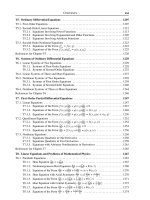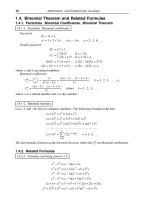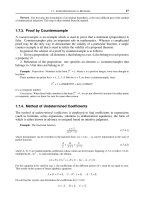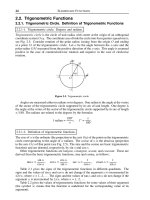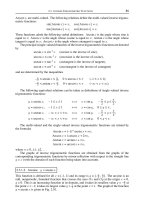Handbook of mathematics for engineers and scienteists part 76 pptx
Bạn đang xem bản rút gọn của tài liệu. Xem và tải ngay bản đầy đủ của tài liệu tại đây (431.1 KB, 7 trang )
12.3. SECOND-ORDER NONLINEAR DIFFERENTIAL EQUATIONS 493
Further, differentiating (12.3.3.1) yields
y
xxx
= f
x
(x, y, y
x
)+f
y
(x, y, y
x
)y
x
+ f
y
x
(x, y, y
x
)y
xx
.(12.3.3.5)
On substituting x = x
0
, the initial conditions (12.3.3.2), and the expression of y
xx
(x
0
)
of (12.3.3.4) into the right-hand side of equation (12.3.3.5), we calculate the value of the
third derivative:
y
xxx
(x
0
)=f
x
(x
0
, y
0
, y
1
)+f
y
(x
0
, y
0
, y
1
)y
1
+ f(x
0
, y
0
, y
1
)f
y
x
(x
0
, y
0
, y
1
).
The subsequent derivatives of the unknown are determined likewise.
The thus obtained solution (12.3.3.3) can only be used in a small neighborhood of the
point x = x
0
.
Example 1. Consider the following Cauchy problem for a second-order nonlinear equation:
y
xx
= yy
x
+ y
3
;(12.3.3.6)
y(0)=y
x
(0)=1.(12.3.3.7)
Substituting the initial values of the unknown and its derivative (12.3.3.7) into equation (12.3.3.6) yields
the initial value of the second derivative:
y
xx
(0)=2.(12.3.3.8)
Differentiating equation (12.3.3.6) gives
y
xxx
= yy
xx
+(y
x
)
2
+ 3y
2
y
x
.(12.3.3.9)
Substituting here the initial values from (12.3.3.7) and (12.3.3.8), we obtain the initial condition for the third
derivative:
y
xxx
(0)=6. (12.3.3.10)
Differentiating (12.3.3.9) followed by substituting (12.3.3.7), (12.3.3.8), and (12.3.3.10), we find that
y
xxxx
(0)=24. (12.3.3.11)
On substituting the initial data (12.3.3.7), (12.3.3.8), (12.3.3.10), and (12.3.3.11) into (12.3.3.3), we arrive at
the Taylor series expansion of the solution about x = 0 :
y = 1 + x + x
2
+ x
3
+ x
4
+ ··· . (12.3.3.12)
This geometric series is convergent only for |x| < 1.
12.3.3-2. Pad
´
e approximants.
Suppose the k + 1 leading coefficients in the Taylor series expansion of a solution to
a differential equation about the point x = 0 are obtained by the method presented in
Paragraph 12.3.3-1, so that
y
k+1
(x)=a
0
+ a
1
x + ···+ a
k
x
k
.(12.3.3.13)
The partial sum (12.3.3.13) pretty well approximates the solution at small x but is poor
for intermediate and large values of x, since the series can be slowly convergent or even
divergent. This is also related to the fact that y
k
→∞as x →∞, while the exact solution
can well be bounded.
In many cases, instead of the expansion (12.3.3.13), it is reasonable to consider a
Pad
´
e approximant P
N
M
(x), which is the ratio of two polynomials of degree N and M ,
specifically,
P
N
M
(x)=
A
0
+ A
1
x + ···+ A
N
x
N
1 + B
1
x + ···+ B
M
x
M
,whereN + M = k.(12.3.3.14)
494 ORDINARY DIFFERENTIAL EQUATIONS
The coefficients A
1
, , A
N
and B
1
, , B
M
are selected so that the k + 1 leading
terms in the Taylor series expansion of (12.3.3.14) coincide with the respective terms of the
expansion (12.3.3.13). In other words, the expansions (12.3.3.13) and (12.3.3.14) must be
asymptotically equivalent as x → 0.
In practice, one usually takes N = M (the diagonal sequence). It often turns out that
formula (12.3.3.14) pretty well approximates the exact solution on the entire range of x
(for sufficiently large N).
Example 2. Consider the Cauchy problem (12.3.3.6)–(12.3.3.7) again. The Taylor series expansion of
the solution about x = 0 has the form (12.3.3.12). This geometric series is convergent only for |x| < 1.
The diagonal sequence of Pad
´
e approximants corresponding to series (12.3.3.12) is
P
1
1
(x)=
1
1 – x
, P
2
2
(x)=
1
1 – x
, P
3
3
(x)=
1
1 – x
. (12.3.3.15)
It is not difficult to verify that the function y(x)=
1
1 – x
is the exact solution of the Cauchy prob-
lem (12.3.3.6)–(12.3.3.7). Hence, in this case, the diagonal sequence of Pad
´
e approximants recovers the exact
solution from only a few terms in the Taylor series.
Example 3. Consider the Cauchy problem for a second-order nonlinear equation:
y
xx
= 2yy
x
; y(0)=0, y
x
(0)=1. (12.3.3.16)
Following the method presented in Paragraph 12.3.3-1, we obtain the Taylor series expansion of the solution
to problem (12.3.3.16) in the form
y(x)=x +
1
3
x
3
+
2
15
x
5
+
17
315
x
7
+ ··· . (12.3.3.17)
The exact solution of problem (12.3.3.16) is given by y(x)=tanx. Hence it has singularities at x =
1
2
(2n + 1)π.However,anyfinite segment of the Taylor series (12.3.3.17) does not have any singularities.
With series (12.3.3.17), we construct the diagonal sequence of Pad
´
e approximants:
P
2
2
(x)=
3x
3 – x
2
, P
3
3
(x)=
x(x
2
– 15)
3(2x
2
– 5)
, P
4
4
(x)=
5x(21 – 2x
2
)
x
4
– 45x
2
+ 105
. (12.3.3.18)
These Pad
´
e approximants have singularities (at the points where the denominators vanish):
x
1.732 for P
2
2
(x),
x
1.581 for P
3
3
(x),
x
1.571 and x 6.522 for P
4
4
(x).
It is apparent that the Pad
´
e approximants are attempting to recover the singularities of the exact solution at
x =
π/2 and x = 3π/2.
In Fig. 12.2, the solid line shows the exact solution of problem (12.3.3.16), the dashed line corresponds
to the four-term Taylor series solution (12.3.3.17), and the dot-and-dash line depicts the Pad
´
e approximants
(12.3.3.18). It is evident that the Pad
´
e approximant P
4
4
(x) gives an accurate numerical approximation of the
exact solution on the interval |x| ≤ 2 ; everywhere the error is less than 1%, except for a very small neighborhood
of the point x =
π/2 (the error is 1% for x = 1.535 and 0.84% for x = 2).
12.3.4. Movable Singularities of Solutions of Ordinary Differential
Equations. Painlev
´
e Transcendents
12.3.4-1. Preliminary remarks. Singular points of solutions.
1
◦
. Singular points of solutions to ordinary differential equations can be fixed or movable.
The coordinates of fixed singular points remain the same for different solutions of an
equation.* The coordinates of movable singular points vary depending on the particular
solution selected (i.e., they depend on the initial conditions).
* Solutions of linear ordinary differential equations can only have fixed singular points, and their positions
are determined by the singularities of the equation coefficients.
12.3. SECOND-ORDER NONLINEAR DIFFERENTIAL EQUATIONS 495
0.5 1
1.5 2
1
4
8
12
1.52
4
8
12
yx x( ) = tan
yx P x()= ()
yx P x()= ()
yx()=x+ x +
1
3
2
3
2
3
3
y
x
O
Figure 12.2. Comparison of the exact solution to problem (12.3.3.16) with the approximate truncated series
solution (12.3.3.17) and associated Pad
´
e approximants (12.3.3.18).
Listed below are simple examples of first-order ordinary differential equations and their
solutions having movable singularities:
Equation Solution Solution’s singularity type
y
z
=–y
2
y = 1/(z – z
0
) movable pole
y
z
= 1/y y = 2
√
z – z
0
algebraic branch point
y
z
= e
–y
y =ln(z – z
0
) logarithmic branch point
y
z
=–y ln
2
yy= exp[1/(z – z
0
)] essential singularity
Algebraic branch points, logarithmic branch points, and essential singularities are called
movable critical points.
2
◦
. The Painlev
´
e equations arise from the classification of the following second-order
differential equations over the complex plane:
y
zz
= R(z, y,y
z
),
where R = R(z,y, w) is a function rational in y and w and analytic in z.Itwasshown
by P. Painlev
´
e (1897–1902) and B. Gambier (1910) that all equations of this type whose
solutions do not have movable critical points (but are allowed to have fixed singular points
and movable poles) can be reduced to 50 classes of equations. Moreover, 44 classes out of
them are integrable by quadrature or admit reduction of order. The remaining 6 equations
are irreducible; these are known as the Painlev
´
e equations or Painlev
´
e transcendents,and
their solutions are known as the Painlev
´
e transcendental functions.
The canonical forms of the Painlev
´
e transcendents are given below in Paragraphs
12.3.4-2 through 12.3.4-6. Solutions of the first, second, and fourth Painlev
´
e transcendents
have movable poles (no fixed singular points). Solutions of the third and fifth Painlev
´
e
transcendents have two fixed logarithmic branch points, z = 0 and z = ∞. Solutions of the
sixth Painlev
´
e transcendent have three fixed logarithmic branch points, z = 0, z = 1,and
z = ∞.
It is significant that the Painlev
´
e equations often arise in mathematical physics.
496 ORDINARY DIFFERENTIAL EQUATIONS
12.3.4-2. First Painlev
´
e transcendent.
1
◦
.Thefirst Painlev
´
e transcendent has the form
y
zz
= 6y
2
+ z.(12.3.4.1)
The solutions of the first Painlev
´
e transcendent are single-valued functions of z.
The solutions of equation (12.3.4.1) can be presented, in the vicinity of movable pole z
p
,
in terms of the series
y =
1
(z – z
p
)
2
+
∞
n=2
a
n
(z – z
p
)
n
,
a
2
=–
1
10
z
p
, a
3
=–
1
6
, a
4
= C, a
5
= 0, a
6
=
1
300
z
2
p
,
where z
p
and C are arbitrary constants; the coefficients a
j
(j ≥ 7) are uniquely defined
in terms of z
p
and C.
2
◦
. In a neighborhood of a fixed point z = z
0
, the solution of the Cauchy problem for
the first Painlev
´
e transcendent (12.3.4.1) can be represented by the Taylor series (see
Paragraph 12.3.3-1):
y = A+B(z –z
0
)+
1
2
(6A
2
+z
0
)(z–z
0
)
2
+
1
6
(12AB+1)(z–z
0
)
3
+
1
2
(6A
3
+B
2
+Az
0
)(z–z
0
)
4
+···,
where A and B are initial data of the Cauchy problem, so that y|
z=z
0
= A and y
z
|
z=z
0
= B.
Remark. The solutions of the Cauchy problems for the second and fourth Painlev
´
e transcendents can be
expressed likewise (fixed singular points should be excluded from consideration for the remaining Painlev
´
e
transcendents).
3
◦
. For large values of |z|, the following asymptotic formula holds:
y ∼ z
1/2
℘
4
5
z
5/4
– a; 12, b
,
where the elliptic Weierstrass function ℘(ζ; 12, b)isdefined implicitly by the integral
ζ =
d℘
4℘
3
– 12℘ – b
;
a and b are some constants.
12.3.4-3. Second Painlev
´
e transcendent.
1
◦
.Thesecond Painlev
´
e transcendent has the form
y
zz
= 2y
3
+ zy + α.(12.3.4.2)
The solutions of the second Painlev
´
e transcendent are single-valued functions of z.
The solutions of equation (12.3.4.2) can be represented, in the vicinity of a movable
pole z
p
, in terms of the series
y =
m
z – z
p
+
∞
n=1
b
n
(z – z
p
)
n
,
b
1
=–
1
6
mz
p
, b
2
=–
1
4
(m + α), b
3
= C, b
4
=
1
72
z
p
(m + 3α),
b
5
=
1
3024
(27 + 81α
2
– 2z
3
p
)m + 108α – 216Cz
p
,
where z
p
and C are arbitrary constants, m = 1, and the coefficients b
n
(n ≥ 6)are
uniquely definedintermsof z
p
and C.
12.3. SECOND-ORDER NONLINEAR DIFFERENTIAL EQUATIONS 497
2
◦
.Forfixed α, denote the solution by y(z, α). Then the following relation holds:
y(z,–α)=–y(z, α), (12.3.4.3)
while the solutions y(z, α)andy(z, α – 1) are related by the B
¨
acklund transformations:
y(z,α – 1)=–y(z,α)+
2α – 1
2y
z
(z, α)–2y
2
(z, α)–z
,
y(z,α)=–y(z,α – 1)–
2α – 1
2y
z
(z, α – 1)+2y
2
(z, α – 1)+z
.
(12.3.4.4)
Therefore, in order to study the general solution of equation (12.3.4.2) with arbitrary α,it
is sufficient to construct the solution for all α out of the band 0 ≤ Re α <
1
2
.
Three solutions corresponding to α and α 1 are related by the rational formulas
y
α+1
=–
(y
α–1
+ y
α
)(4y
3
α
+ 2zy
α
+ 2α + 1)+(2α – 1)y
α
2(y
α–1
+ y
α
)(2y
2
α
+ z)+2α – 1
,
where y
α
stands for y(z,α).
The solutions y(z, α)andy(z,–α – 1) are related by the B
¨
acklund transformations:
y(z,–α – 1)=y(z, α)+
2α + 1
2y
z
(z, α)+2y
2
(z, α)+z
,
y(z,α)=y(z,–α – 1)–
2α + 1
2y
z
(z,–α – 1)+2y
2
(z,–α – 1)+z
.
3
◦
.Forα = 0, equation (12.3.4.2) has the trivial solution y = 0. Taking into account this
fact and relations (12.3.4.3) and (12.3.4.4), we find that the second Painlev
´
e transcendent
with α =
1, 2, has the rational particular solutions
y(z,
1)=
1
z
, y(z, 2)=
1
z
–
3z
2
z
3
+ 4
,
For α =
1
2
, equation (12.3.4.2) admits the one-parameter family of solutions:
y(z,
1
2
)=–
w
z
w
,wherew =
√
z
C
1
J
1/3
√
2
3
z
3/2
+ C
2
Y
1/3
√
2
3
z
3/2
.(12.3.4.5)
(Here, the function w is a solution of the Airy equation, w
zz
+
1
2
zw = 0.) It follows
from (12.3.4.3)–(12.3.4.5) that the second Painlev
´
e transcendent for all α = n +
1
2
with
n = 0, 1, 2, has a one-parameter family of solutions that can be expressed in terms
of Bessel functions.
12.3.4-4. Third Painlev
´
e transcendent.
1
◦
.Thethird Painlev
´
e transcendent has the form
y
zz
=
(y
z
)
2
y
–
y
z
z
+
1
z
(αy
2
+ β)+γy
3
+
δ
y
.(12.3.4.6)
In terms of the new independent variable ζ defined by z = e
ζ
, the solutions of the
transformed equation will be single-valued functions of ζ.
In some special cases, equation (12.3.4.6) can be integrated by quadrature.
498 ORDINARY DIFFERENTIAL EQUATIONS
2
◦
. Any solution of the Riccati equation
y
z
= ky
2
+
α – k
kz
y + c,(12.3.4.7)
where k
2
= γ, c
2
=–δ, kβ +c(α –2k)=0, is a solution of equation (12.3.4.6). Substituting
z = λτ , y =–
u
z
ku
,whereλ
2
=
1
kc
, into (12.3.4.7), we obtain a linear equation
u
ττ
+
k – α
kτ
u
τ
+ u = 0,
whose general solution is expressed in terms of Bessel functions:
u = τ
α
2k
C
1
J
α
2k
(τ)+C
2
Y
α
2k
(τ)
.
12.3.4-5. Fourth Painlev
´
e transcendent.
1
◦
.Thefourth Painlev
´
e transcendent has the form
y
zz
=
(y
z
)
2
2y
+
3
2
y
3
+ 4zy
2
+ 2(z
2
– α)y +
β
y
.(12.3.4.8)
The solutions of the fourth Painlev
´
e transcendent are single-valued functions of z.
The Laurent-series expansion of the solution of equation (12.3.4.8) in the vicinity of a
movable pole z
p
is given by
y =
m
z – z
p
– z
p
–
m
3
(z
2
p
+ 2α – 4m)(z – z
p
)+C(z – z
p
)
2
+
∞
j=3
a
j
(z – z
p
)
j
,
where m =
1; z
p
and C are arbitrary constants; and the a
j
(j ≥ 3) are uniquely defined
in terms of α, β, z
p
,andC.
2
◦
. Two solutions of equation (12.3.4.8) corresponding to different values of the parameters
α and β are related to each other by the B
¨
acklund transformations:
y =
1
2sy
(y
z
– q – 2szy – sy
2
), q
2
=–2β,
y =–
1
2sy
(y
z
– p + 2szy + sy
2
), p
2
=–2
β,
2β =–(αs – 1 –
1
2
p)
2
, 4α =–2s – 2α – 3sp,
where y = y(z, α, β), y = y(z, α,
β), and s is an arbitrary parameter.
3
◦
. If the condition β + 2(1 + αm)
2
= 0,wherem = 1, is satisfied, then every solution
of the Riccati equation
y
z
= my
2
+ 2mzy – 2(1 + αm)
is simultaneously a solution of the fourth Painlev
´
e equation (12.3.4.8).
12.3. SECOND-ORDER NONLINEAR DIFFERENTIAL EQUATIONS 499
12.3.4-6. Fifth and sixth Painlev
´
e transcendents.
1
◦
.Thefifth Painlev
´
e transcendent has the form
y
zz
=
3y – 1
2y(y – 1)
(y
z
)
2
–
y
z
z
+
(y – 1)
2
z
2
αy +
β
y
+ γ
y
z
+
δy(y + 1)
y – 1
.
2
◦
.Thesixth Painlev
´
e transcendent has the form
y
zz
=
1
2
1
y
+
1
y – 1
+
1
y – z
(y
z
)
2
–
1
z
+
1
z – 1
+
1
y – z
y
z
+
y(y – 1)(y – z)
z
2
(z – 1)
2
α + β
z
y
2
+ γ
z – 1
(y – 1)
2
+ δ
z(z – 1)
(y – z)
2
.
For details about these equations, see the list of references given at the end of the current
chapter.
12.3.5. Perturbation Methods of Mechanics and Physics
12.3.5-1. Preliminary remarks. A summary table of basic methods.
Perturbation methods are widely used in nonlinear mechanics and theoretical physics for
solving problems that are described by differential equations with a small parameter ε.
The primary purpose of these methods is to obtain an approximate solution that would be
equally suitable at all (small, intermediate, and large) values of the independent variable as
ε → 0.
Equations with a small parameter can be classified according to the following:
(i) the order of the equation remains the same at ε = 0;
(ii) the order of the equation reduces at ε = 0.
For the first type of equations, solutions of related problems* are sufficiently smooth (little
varying as ε decreases). The second type of equation is said to be degenerate at ε = 0,
or singularly perturbed. In related problems, thin boundary layers usually arise whose
thickness is significantly dependent on ε; such boundary layers are characterized by high
gradients of the unknown.
All perturbation methods have a limited domain of applicability; the possibility of
using one or another method depends on the type of equations or problems involved. The
most commonly used methods are summarized in Table 12.3 (the method of regular series
expansions is set out in Paragraph 12.3.5-2). In subsequent paragraphs, additional remarks
and specific examples are given for some of the methods. In practice, one usually confines
oneself to few leading terms of the asymptotic expansion.
In many problems of nonlinear mechanics and theoretical physics, the independent
variable is dimensionless time t. Therefore, in this subsection we use the conventional t
(0 ≤ t < ∞) instead of x.
* Further on, we assume that the initial and/or boundary conditions are independent of the parameter ε.



